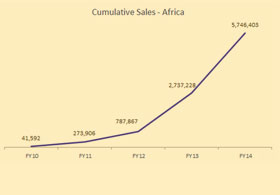Solar Lighting Products Improve Energy Access for 28.5 Million People in Africa

More than 28.5 million people across Africa now have access to modern lighting as a result of switching from kerosene lanterns to solar lighting products, according to results from the IFC-World Bank Lighting Africa program.
Families not connected to grid electricity in Africa spend some USD 10 billion every year on kerosene to light up their homes. By switching to solar and other sources of clean lighting, the kerosene expenditure could be directed towards improving the education and health of their families, and start life transforming income generating activities.
In 2009, less than one percent of the population in Africa was using modern LED solar lighting products.Now about five percent (4.8%) of the population is using solar lighting as a result of Lighting Africa’s market development work, implemented in partnership with various players along the supply chain.
“At this rate we are confident that sustainable energy for all in the next 15 years is indeed achievable as the market for modern solar lights doubles every year,” says Itotia Njagi, the IFC Lighting Africa Program Manager.
Aggregated sales data from distributors and marketers of quality-verified solar lighting products shows that the market recorded110 percent growth for the year ended July 2014, pointing to the large unmet demand for clean energy products and systems in Africa.
The IFC-World Bank Lighting Africa is currently working with 39 client companies who have brought to market a wide choice of durable, affordable solar lighting products that are providing not only lighting services, but also communication services, through cellphone charging, to families not connected to grid electricity, or with unreliable supply.
“What is all the more encouraging is that we have created demand for not only clean lighting products at the bottom of the pyramid, but also for a wider range of energy services available to those connected to grid electricity,” adds Itotia Njagi.
The African market for off-grid solar lighting has seen a number of transformations in the past four years.Consumers are asking for larger energy systems that can power more than one light and appliances such as fans, radios and television.
There has also been a marked shift towards product quality and durability in response to consumer demands; products that meet the Lighting Global quality standards now command half (50%) the off-grid market share up from barely 3% in 2009.

